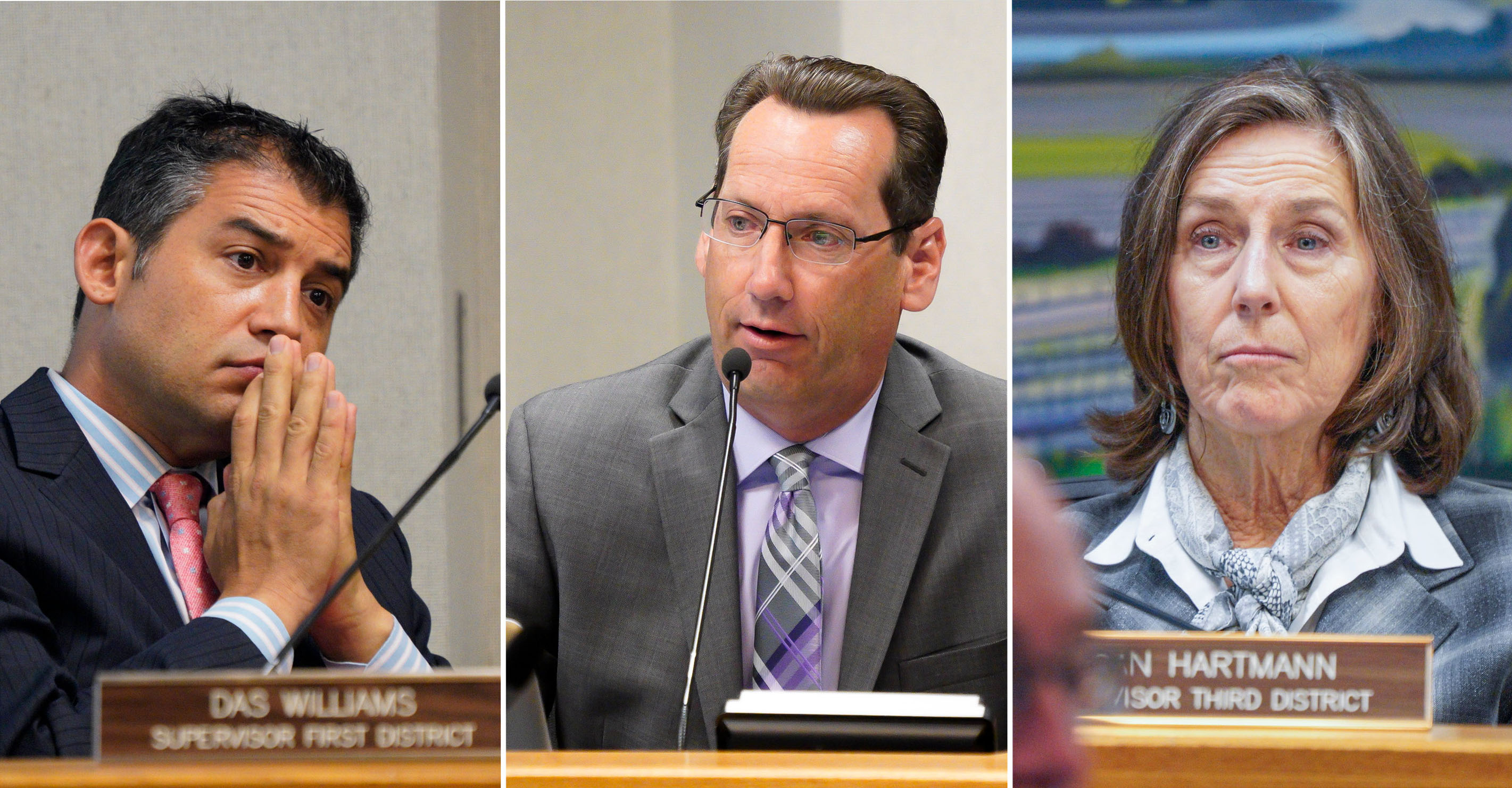Santa Barbara Cannabis Hearings Long and Unresolved
Dramatic Power Outage Forces Meeting to Delay Final Vote on Ordinance Changes

The county’s much-embattled cannabis industry was not saved so much by the bell this Tuesday evening as it was by a random car crash late in the afternoon when an errant Santa Maria driver collided with a power pole, knocking out electrical services for 4,111 properties, most notably the Joe Centeno government center. That loss of power forced all five county supervisors to switch rooms and scramble — devising a combination of a tablet, a cell phone, and a Facebook page — to keep the meeting going, thus allowing every member of the public who wanted to testify, including those in downtown Santa Barbara, to speak their piece.
By the time the exhausting 10-hour public meeting adjourned at 7:10 p.m., more than 200 speakers had done just that.
Both sides successfully amassed their respective troops for a knock-down-drag-out over a series of votes that partisans for and against the new industry believed would significantly control how cannabis growers could continue to cultivate in Santa Barbara County.
Supporters of the burgeoning industry were mostly frontline cannabis workers, decidedly younger and ethnically mixed, who expressed a gratitude that bordered on economic desperation for new jobs that pay considerably higher than minimum wage and come with medical, dental, and vacation benefits. They argued the new restrictions were unnecessary and that it was too soon to conclude that the county’s existing cannabis ordinance had failed to get the job done.
The other side — city leaders from Carpinteria, Goleta, and Solvang — argued the new regulations didn’t go nearly far enough on an industry they insisted constituted an existential threat to their characters and ways of life. Some, like Goleta’s Mayor Paula Perrotte, objected that the supervisors had ignored their input. Only Lompoc’s mayor, Jenelle Osborne, sang a contrary tune. Lompoc has opened its arms to the new industry, imposing no caps on the number of retail outlets, for example, even allowing retail lounges where cannabis customers can hang out and inhale, imbibe, or otherwise ingest the product of their choice.
But for the car crash, it appeared likely that a majority of supervisors might have endorsed some sort of cap on the amount of cannabis that could be cultivated in Santa Barbara, the only coastal county that has no such cap. Totally undiscussed, however, was any sense of how tight the cap and how much cannabis would be allowed. Any such cap would be a major political shift in board cannabis policy, though no deliberations took place Tuesday due to the power outage.
Also left undeliberated was a cluster of smaller but significant tweaks to the ordinance that would have required cannabis operators to install odor-control systems much sooner. This measure, which would require the systems be installed before operators apply for business licenses, clearly had the votes necessary to pass. Odor seepage has been an especially intense issue in Carpinteria where rows of greenhouses line a 2.6-mile stretch of road. Also, it appears there are votes for a new requirement that all greenhouse applicants conduct meteorological studies so that it’s easier to pinpoint from which greenhouse the odors originate.

Less certain will be the fate of proposals to increase buffer distances between cannabis operations and neighboring sites — like schools — from 750 feet to a mile, or proposals sought by the City of Goleta for the county to create a major buffer between cannabis operations and its urban limit line. Cannabis operations now flourish less than a mile downwind from the Bacara resort, Goleta officials complained. Supervisor Steve Lavagnino, a strong proponent of the new cannabis industry, was clearly not sympathetic, archly noting that the City of Goleta itself had opened its doors to no less than six retail dispensaries.
Earlier in the day, the supervisors did vote unanimously to expand the number of people who must be notified when cannabis operations seek various land-use permits. They also voted — though only conceptually — to ban outright any cannabis operations on smaller agricultural parcels — less than 20 acres located inland from the coast. Cannabis will still be allowed on smaller agriculturally zoned parcels of more than 20 acres, but the land use permitting hoops will be significantly more stringent. The cannabis industry complained that it currently costs up to $200,000 for technical studies needed to apply for land-use permits. By upping the ante, they warned — as did Sara Rotman, a onetime fashionista branding maven who started growing cannabis upon moving to Santa Barbara in response to chronic health issues — the county is introducing a disruptive level of uncertainty that will make it that much harder for lawful operators to get through the system. Black-market operators — disdainful of county rules — will be allowed to proliferate, they warned.
NEW NEWS, SORT OF
As exhausting as Tuesday’s marathon proved, significant new information emerged. The County’s Air Pollution Control District (APCD), Supervisor Das Williams reported, concluded that none of the active ingredients deployed in the leading odor-control system — used in 12 Carpinteria greenhouses — are “toxic pollutants as defined by the state of California.” Critics had expressed fear that systems could become smog precursors when combined with sunlight. The APCD’s finding will probably not comfort some cannabis critics who fear the long-term exposure to as much as 450,000 pounds of chemically treated vapors annually.
Cannabis grower John De Friel, a major player with the Lompoc Growers Association along with Rotman, leaked preliminary results of an economic study prepared by UCSB’s Economic Forecast project indicating the cannabis industry created 6,000 new jobs — either directly, indirectly, or induced — and injected $453 million a year into the local economy. That report, stated author Peter Rupert, remains highly preliminary. De Friel had been accused earlier that day by an industry critic of lying on an affidavit claiming to have been growing medicinal plants prior to January 19, 2016, the cutoff date for the county to award growers the protection of legal nonconforming status. The critic provided before and after photographs from Google Earth to make his case. De Friel stated he had no association with the company in question and that the photographs were not of his property.

When Maureen Claffey, a particularly vocal critic of the county’s enforcement shortcomings against nuisance operators, complained of “a failure of moral imagination,” Supervisor Williams — whose district includes Carpinteria where he resides with his wife and two children — countered that an industry that provided so many jobs clearly had a moral component to it.
A key player who’s helped foment the gathering opposition to the county’s cannabis industry has been Sara Miller McCune, owner of Sage Publishing and a serious heavy hitter in Santa Barbara’s philanthropic and political circles. Until Tuesday, McCune’s involvement was understood but never stated. At Tuesday’s hearing, a McCune emissary read a letter from McCune. “I am furious about the leniency and proliferation of permits for cannabis which Das Williams is foisting upon us with the aid of most of our supervisors.”
Williams and Supervisor Steve Lavagnino were unfavorably depicted in a recent Los Angeles Times article as being unduly cozy with cannabis lobbyists and taking campaign donations from the cannabis industry. Lavagnino delivered a passionate response saying he could not let allegations that he had acted “unethically” go unchecked. He said he did attend a fundraiser for the Special Olympics with a cannabis business representative, but he paid for both tickets. “Who paid for it? I did,” he exclaimed. Lavagnino hoped the cannabis industry could provide a new revenue stream now that the oil industry appears on the wane. It takes money, he said, to provide needed help for mental health, homeless services, road repairs, and a response to climate change.
The issue will be revisited at the supervisors’ July 16 hearing.




You must be logged in to post a comment.